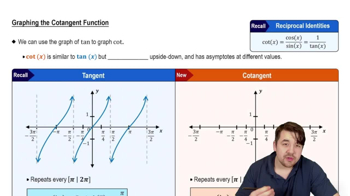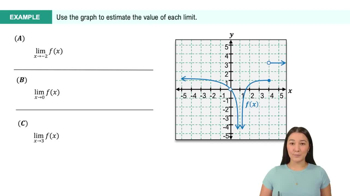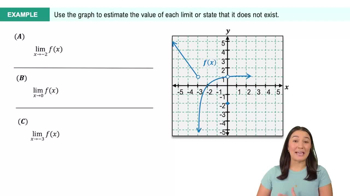Table of contents
- 0. Functions7h 52m
- Introduction to Functions16m
- Piecewise Functions10m
- Properties of Functions9m
- Common Functions1h 8m
- Transformations5m
- Combining Functions27m
- Exponent rules32m
- Exponential Functions28m
- Logarithmic Functions24m
- Properties of Logarithms34m
- Exponential & Logarithmic Equations35m
- Introduction to Trigonometric Functions38m
- Graphs of Trigonometric Functions44m
- Trigonometric Identities47m
- Inverse Trigonometric Functions48m
- 1. Limits and Continuity2h 2m
- 2. Intro to Derivatives1h 33m
- 3. Techniques of Differentiation3h 18m
- 4. Applications of Derivatives2h 38m
- 5. Graphical Applications of Derivatives6h 2m
- 6. Derivatives of Inverse, Exponential, & Logarithmic Functions2h 37m
- 7. Antiderivatives & Indefinite Integrals1h 26m
- 8. Definite Integrals4h 44m
- 9. Graphical Applications of Integrals2h 27m
- 10. Physics Applications of Integrals 2h 22m
1. Limits and Continuity
Introduction to Limits
Problem 33e
Textbook Question
Determine whether the following statements are true and give an explanation or counterexample.
e. . (Hint: Graph y=cot x)
 Verified step by step guidance
Verified step by step guidance1
insert step 1: Recall the definition of the cotangent function, which is \( \cot x = \frac{\cos x}{\sin x} \).
insert step 2: Consider the behavior of \( \sin x \) and \( \cos x \) as \( x \to \frac{\pi}{2} \). Note that \( \sin \left( \frac{\pi}{2} \right) = 1 \) and \( \cos \left( \frac{\pi}{2} \right) = 0 \).
insert step 3: Substitute these values into the cotangent function: \( \cot x = \frac{\cos x}{\sin x} \to \frac{0}{1} = 0 \).
insert step 4: However, consider the limit \( \lim_{x \to \frac{\pi}{2}} \cot x \). As \( x \) approaches \( \frac{\pi}{2} \) from the left, \( \cos x \) approaches 0, but \( \sin x \) is positive and close to 1, making \( \cot x \) approach 0.
insert step 5: As \( x \) approaches \( \frac{\pi}{2} \) from the right, \( \cos x \) is still approaching 0, but \( \sin x \) is negative and close to -1, making \( \cot x \) approach 0. Thus, the limit does not exist as it approaches different values from the left and right.
 Verified video answer for a similar problem:
Verified video answer for a similar problem:This video solution was recommended by our tutors as helpful for the problem above
Video duration:
1mPlay a video:
Was this helpful?
Key Concepts
Here are the essential concepts you must grasp in order to answer the question correctly.
Limit of a Function
The limit of a function describes the behavior of that function as the input approaches a certain value. In this case, we are interested in the limit of the cotangent function as x approaches π/2. Understanding limits is crucial for analyzing the continuity and behavior of functions at specific points, especially where they may not be defined.
Recommended video:

Limits of Rational Functions: Denominator = 0
Cotangent Function
The cotangent function, denoted as cot(x), is the reciprocal of the tangent function, defined as cot(x) = cos(x)/sin(x). It is important to note that cot(x) is undefined at points where sin(x) = 0, such as x = nπ, where n is an integer. This characteristic affects the limit as x approaches π/2, where the function exhibits vertical asymptotic behavior.
Recommended video:

Introduction to Cotangent Graph
Graphical Analysis
Graphical analysis involves examining the graph of a function to understand its behavior visually. For the cotangent function, plotting y = cot(x) reveals that as x approaches π/2, the function tends toward negative infinity, not zero. This visual representation helps clarify the limit's value and provides insight into the function's discontinuities and asymptotes.
Recommended video:

Derivatives Applied To Velocity

 6:47m
6:47mWatch next
Master Finding Limits Numerically and Graphically with a bite sized video explanation from Callie
Start learning





